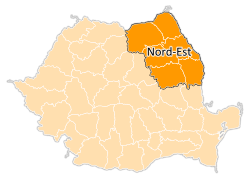Nord-Est (development region)
Nord-Est (North East) or Nord-Est Moldova is a development region in Romania.
Nord-Est | |
|---|---|
Region | |
 | |
| Country | Romania |
| Development Agency HQ | Piatra Neamț |
| Largest city | Iași |
| Area | |
| • Total | 36,850 km2 (14,230 sq mi) |
| Population (2011) | |
| • Total | 3,302,217 |
| • Rank | 1st |
| • Density | 90/km2 (230/sq mi) |
| Ethnic groups | |
| • Romanians | 97.9% |
| • Roma | 1.2% |
| • Ukrainians | 0.3% |
| Time zone | UTC+2 (EET) |
| • Summer (DST) | UTC+3 (EEST) |
| NUTS code | RO21 |
| GDP per capita (PPS) | €9,500 (2014)[1] |
| Website | www |
Counties
changeThe Nord-Est region is made up of these counties:
| County | population 2011 |
|---|---|
| Bacău | 637,706 |
| Botoşani | 404,429 |
| Iaşi | 774,165 |
| Neamţ | 507,399 |
| Suceava | 654,870 |
| Vaslui | 393,340 |
| Total | 3,371,909 |
Economy
changeThe economy of Nord-Est region is mainly agricultural, especially towards the north, even though there are many industrial cities, especially Iaşi, Bacău and Suceava. The regional GDP per capita is the lowest in Romania, at about two-thirds of the national average. Botoşani and Vaslui are sometimes thought to be the poorest counties in Romania. However, Iaşi, the largest city in Nord-Est is one of the rich cities of the region. The region's richest counties are, in order, Iaşi, Bacău, Suceava, Neamţ, Vaslui and Botoşani.
Demographics
changeIn total, 3,371,909 people (2011 Census) live in Nord-Est. This makes it the region in the country with the most people. Its population density is 91.25/km².
As of 2002 the region has a big amount of Romanians, of 97.9%, with the second largest group being the Roma, who make up 1.2% of the population. Other groups, including Ukrainians, make up the rest of the population (0.9%).
Romanian is the most-spoken language. It is spoken as a first language by 98.7% of the people who live in the region. Traditional languages include Romany, spoken by 0.6% of the population, and Ukrainian (0.3%).
References
change- ↑ Eurostat (26 February 2016). "GDP per capita in the EU in 2014". Europa web portal. Retrieved 28 February 2016.